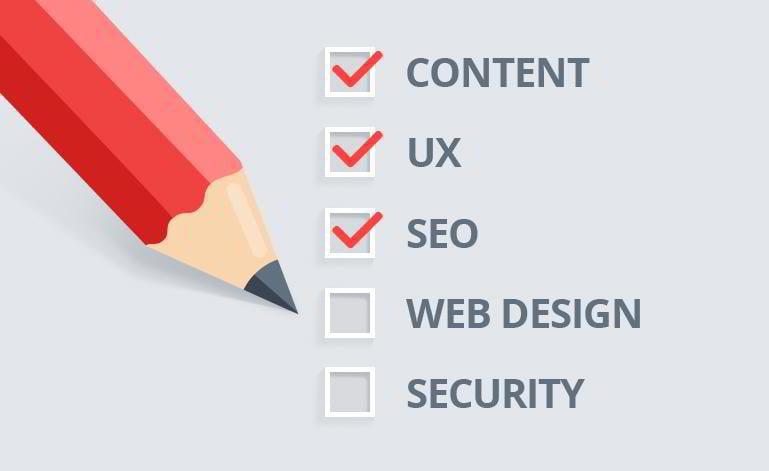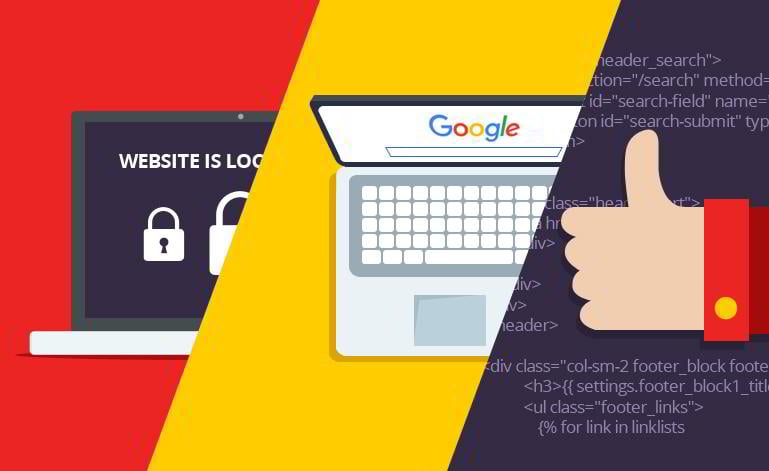Simon Morgan
Simon is a TemplateMonster sales operator who helps small businesses and startups by day and passionately rocking on the stage with his bass guitar by night. Simon is a truly creative spirit and idea generator who can draw almost everything he imagines.
There are millions of web pages on the web but...how many of them are truly good? And what is good anyway? You must know, intuitively. Have you ever visited a website and wanted to leave it after just a few seconds of browsing? Have you ever visited a website and realized that you’ve spent over half an hour browsing it, but haven’t got tired of it yet? We bet that’s the kind of website you would like to create for yourself and your business. Let’s see how to accomplish that.
You’ll Learn About:
1. Content
As Bill Gates pointed out back in 1996, “content is king.” That is why it is number one on our list. Whatever your site is about, content is paramount, and it is becoming even more so with every passing year.
If you have an informational site, your content has to provide real value to your readers so that people will want to share it. If you have an online store, there are numerous ways to market your products with useful content.You can check them here. For more information on content marketing, see http://contentmarketinginstitute.com/getting-started/.
Your content is also the message you are sending to your visitor, so it has to be understandable, clear and easy to read.
- Do not use complicated grammatical structures. Write in short sentences and easy language.
Make sure you proof-read the text and correct any mistakes and typos. It’s even better if you can get a friend or colleague to proofread your texts because it is usually impossible to notice all your own mistakes. - Do not put too much content on your home page (unless it is a landing page).
- And above all, make sure your content is unique. Do not copy and paste it from other sites as this will do no good either for your users or your site’s ranking in search engines. Read more about search engine ranking here.
“Contact” and “About” information
Would you trust a business which has no contacts? Probably not. That is why you should have a “Contact Us” page on your website or add contact information to the footer, header or the homepage. A “Contact Us” form is a useful tool, which lets the visitor shoot you an email without opening their email box or copying and pasting your email address.
Do not forget about visualization - add a Google map with your location pinned on it. Seeing contact information and understanding that there is a live person behind this website will help your business to gain trust among your customers.
A nice “About” page will do the same. Tell the visitors about yourself and your team, the story of what you do. Try to be brief, but entertaining. These tips and guidelines might help you.
2. UX and SEO
Having established that content is the most important thing on a site, the runner up is User Experience or UX. UX is how accessible your content is to your visitors, how intuitive and user-friendly your site is, how findable your articles or products are, etc.
"User experience design is the process of enhancing user satisfaction by improving the usability, accessibility, and pleasure provided in the interaction between the user and the product. " (source: Wikipedia)
If your site has great UX, your visitors will get satisfaction from using it. What’s more, search engines will rank you higher.
This brings us to search engine optimization (SEO). In the early years of search engines, they displayed search results based exclusively on the content of web pages (or rather on the keywords in that content). Google pioneered the use of backlinks as a means of ranking a page’s value, which spurred the development of SEO as an industry. Now marketers not only crammed keywords into texts and headings, but also arranged link exchange deals with other site owners.
Since then, both search engine algorithms and SEO strategies have evolved drastically. Nowadays, both content quality and UX are essential aspects governing how high your site is going to be ranked among your competitors in a keyword search.
You can read more about usability and SEO here. Below, we will consider the most obvious aspects of UX which will also benefit your SEO.
Structure and accessibility of content
How you structure your content is almost as important as the content itself. The information on your site has to be well arranged and easy to find both for users and for search engine bots, with pages reachable via text links.
“Every click or interaction should take the user closer to their goal while eliminating as much of the non-destination as possible.” (source: http://uxmyths.com/post/654026581/myth-all-pages-should-be-accessible-in-3-clicks)
Search is a helpful tool you can use on a large site. Most Content Management Systems and eCommerce engines have a search option included. For a large site, especially one that is a directory or an online store, you can enhance the basic search with engine-specific extensions.
However, most users, as well as most bots, will rely on inner site navigation to find information on your site. And navigation starts with the menu. It’s best to make it sticky or floating. It should always be in front of the visitor when they scroll down, so that they can see all menu items and switch between them at any moment.
Do not overload the main menu with multiple tabs. A way to avoid that is to build a hierarchy of your web pages, break them into groups and create submenus for each group. If you’ve got lots of pages, try not to bury them deep inside the architecture, but use flat site structure instead.
How you name your menu items is crucial for your site’s SEO. If you want your site frequented by visitors, names of your categories and sub-categories should match their search queries, so as soon as you’ve established what your site is going to be about, invest some time in keyword research in your niche and implement the findings into site building.
Valid Coding
Valid coding is an essential item in the perfect website checklist. Messed up code can prevent your site from being displayed correctly in browsers and on mobile devices, it can increase your pages' load times, and harm the search engine visibility. Valid code, on the other hand, will boost your site.
You can use the following code validators to help you check and clean up your HTML and CSS code.
HTML validators:
- W3.org Validator
- FreeFormatter.com
- HTMLhelp.com Validator
CSS validators:
Upload Time
What’s the most priceless thing in the world? Time. You can’t make your visitors wait 10 seconds to see your website... because they won’t. Research has established that most customers will abandon slow loading pages for faster sites of competitors.
So how do you make your website load more quickly? First, look at the item above. Valid coding is the most important aspect that determines upload speed. But there are a few more strategies to keep in mind:
- Optimize the size of the images using an image editor like Photoshop or any online image size optimizer (all images should load within 3-4 seconds).
- Do not overload your home page with useless information.
- Use the Lazy Load effect which helps to increase the upload speed as your content will appear on the page only if the visitor has scrolled down to it (if it's not already in your theme, you can use a plugin to add it).
Mobile optimization and responsiveness
Every web developer, designer or marketer will tell you that responsiveness and mobile optimization are “must have” features. If your website is not responsive, visitors using a phone will have to zoom in, scroll horizontally, deal with barely clickable buttons, which will all make them very frustrated. Is this something you want your visitors to go through? Moreover, your pages will be ranked lower in search engines for users browsing from phones and tablets. So make sure your website is responsive and readable by all modern mobile devices.
Here are some tools that will help you to check your website mobile friendliness:
For other aspects of mobile optimization, check our guide "Why is it important to have a responsive and mobile friendly website?".
SEO Optimization
Let’s recap the SEO strategies mentioned in the items above:
- Write unique content, do not copy and paste from other sites.
- Create valuable content – something that your visitors will really want to read (here is one more resource to help you with that).
- Use keywords relevant to your business both in navigation and in texts.
- Create a clear site structure with good interlinking between the pages.
- Whatever CMS you’re using, choose a responsive theme with valid coding.
- Keep your site mobile-friendly.
Here are some additional SEO tactics to help your site rank better:
- Add unique HTML title tags to every page of your website (these titles will be displayed as your page headline in search engine results). Make sure the titles contain your keywords, but are not longer than 60 characters.
- Write unique meta descriptions for the main pages of your website.
- Make your URLs SEO-friendly - containing words, not numbers and symbols - so that users and search engine bots can understand the subject of a page just by its URL.
- Optimize your images.
- Create a sitemap of your website and submit it to Google’s Webmaster tools.
- Test if Google can crawl your website.
- Use analytics tools like Google Analytics to be able to analyze your website traffic.
You can check these “all-round” articles on basic on-site SEO to help you develop your SEO strategy:
- http://searchengineland.com/seo-checklist-for-startup-websites-170965
- https://moz.com/beginners-guide-to-seo/basics-of-search-engine-friendly-design-and-development
3. Web Design
You may be wondering why we placed design next to last in our list of great site features. Here is why. While design is the first thing your visitors will see, it should not be your focus from the very beginning.
Design is an instrument that helps bring out your content, and should be subject to it. While in some rare cases extravagant design is needed to inspire awe and admiration in the visitors, most of the time the success of design is defined by how it helps them interact with content.
So, choose the design carefully after you have planned out your content and the site structure. Design trends change all the time, so we will not delve into that. Instead, we will devote some attention to the constants in this field - important aspects of typography, images and colors.
If you feel lost with a web design a little bit, visit TemplateMonster and take a look at the collection of website templates there.
Typography
The way content is written graphically is really important for your users’ satisfaction and, therefore, the UX of your site. Content has to be readable. So it’s best to use easy to read font sizes (12-16) and legible fonts like Arial.
A custom font can add some ginger to your design, but make sure to use it in a “web-safe” way. You can find a myriad of custom fonts for different languages on Google Fonts.
The text background has to contrast with the text itself. Black text on white background is classic, but other combinations can also work. If you are using an image for the content background, check whether the text is clearly visible on it. If not, try altering the text color to reach maximum contrast, or change the image.
Images
Let’s admit it, we’re all a little bit like kids inside. When we see something with no images and just words all the way down, it becomes boring by default, before we even start reading it. So add some images to your website. A slider at the top will be a great way to showcase your business primary features.
In addition, you can add a few images to the content (3-6 images per page), add some icons to make the web page more visually appealing, include infographics, charts, tables, videos. However, do not get carried away. Too many visual elements can make your website more confusing than entertaining.
On the technical side, use high quality, professional images only. Any terrific web design can be ruined by a low quality or poorly retouched image. Always choose images with proper dimensions. If you're using a template where the slider is 960 X 300 px, make sure that the image you insert there is at least that big. Otherwise, it will look horrible. Trying to save on images is shooting yourself in the foot.
At the same time, remember that large images can slow your site down, harming UX and SEO. So optimize them for the web and try to find a fine balance between the number of images you want to use on a page and the time it takes for them to load.
Colors
A well-balanced set of colors will please the visitor’s eye. It is recommended to combine up to 3 colors on your web page. Using fewer colors may turn your site dull. Too many colors, on the other hand, can make it look gaudy and cause visual "convulsions" in your visitors.
Think out the color choice well because:
- It’s scientifically proven that colors can provoke specific emotions in people. Yellow is the color of happiness and warmth; red is aggressive, sharp, fatal; blue is a calm color; white is neutral and good for mixing with the rest of the palette.
- Specific businesses require specific colors. Have you ever seen a lawyer’s website in pink or a black and gray children’s summer camp site? Colors you choose must correspond to your business.
Here are some tools to help you find your color scheme:
4. Security
The last, but definitely not the least feature. Imagine your website is your house. Once you have completed its construction, painted the walls, installed a pool in the backyard and spread a beautiful lawn in the front yard, the last thing you want to happen is for it to be robbed or blown away by a tornado. So what should you do? Take care of your website protection:
- Keep the site backed up - hosting companies usually provide backups as part of the package or for additional fees; you can also use backup plugins.
- Install additional hackers and spam protection plugins - security plugins are among the most requested ones, so you can find lots of them on the web.
- Protect the content - purchase content protection services
First of all, check what protection services are offered by your hosting company. Then you can add more solutions if you feel that those are insufficient.
The aspects listed above are just the basics of creating a great website. There are many more tools and tricks on the road to a commercially successful site with lots of daily traffic, positive reviews and high conversion rates. But unless the basics are taken care of, the more sophisticated strategies may just not work.
Let us know if this list was helpful. If you have questions or feel like there are other points worth mentioning, please share them in the comments. Make sure to sign up to our newsletter to be posted about new guides.



